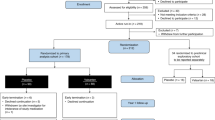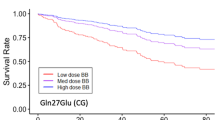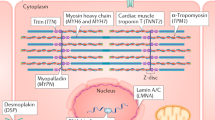Abstract
In heart failure, the Arg16Gly and Gln27Glu polymorphisms of the β2-adrenoreceptor (β2-AR) gene are associated with exercise-capacity, clinical outcomes and response to β-AR blocker therapy. Whether β2-AR gene variants mediate these effects in-part through an impact on cardiac structural remodeling and pump function independent of the effects of β-blockers is uncertain. We evaluated whether the Arg16Gly and Gln27Glu variants of the β2-AR gene predict left ventricular ejection fraction (LVEF) and LV end diastolic diameter (LVEDD) in patients with idiopathic dilated cardiomyopathy (IDC) before and 6 months after receiving standard medical therapy other than β-AR blockers. In all, 394 patients with IDC and 393 age and gender-matched controls were genotyped for the β2-AR gene variants using restriction-fragment length polymorphism-based techniques. LVEF and dimensions were determined in 132 patients (of whom 71 were newly diagnosed) both at baseline and after 6 months. Genotype of neither variant was associated with the presence of IDC. Moreover, β2-AR genotype did not determine LVEF or LV dimensions prior to initiating therapy. After 6 months of therapy, LVEF increased by 7.1±1.0 absolute units (P<0.0001) and LVEDD decreased by 0.27±0.06 cm (P<0.02). Adjusting for baseline values as well as gender, age, and type of angiotensin-converting enzyme inhibitor therapy received, genotype was associated with neither final LVEF and LVEDD, nor change in LVEF and LVEDD. In conclusion, these data suggest that in heart failure, the functional Arg16Gly and Gln27Glu variants of the β2-AR gene have no independent effect on adverse structural remodeling and pump function.
This is a preview of subscription content, access via your institution
Access options
Subscribe to this journal
Receive 6 print issues and online access
$259.00 per year
only $43.17 per issue
Buy this article
- Purchase on Springer Link
- Instant access to full article PDF
Prices may be subject to local taxes which are calculated during checkout
Similar content being viewed by others
References
Communal C, Singh K, Sawyer DB, Colucci WS . Opposing effects of β1 and β2-adrenergic receptors on cardiac myocyte apoptosis: role of a pertussis-toxin sensitive G protein. Circulation 1999; 100: 2210–2212.
Mann DL, Kent RL, Parsons B, Cooper IV G . Adrenergic effects on the biology of the adult mammalian cardiocyte. Circulation 1992; 85: 790–804.
Esler M, Kaye D, Lambert G, Esler D, Jennings G . Adrenergic nervous system in heart failure. Am J Cardiol 1997; 80: 7L–14L.
Bristow M . β-adrenergic receptor blockade in chronic heart failure. Circulation 2000; 101: 558–569.
Molenaar P, Parsonage WA . Fundamental considerations of β-adrenoceptor subtypes in human heart failure. Trends Pharmacol Sci 2005; 26: 368–375.
Bristow MR, Ginsburg B, Fowler M, Minobe W, Rasmussen B, Zera P et al. 1-and β2-adrenergic receptor subpopulations in normal and failing human ventricular myocardium: coupling of both receptor subtypes to muscle contraction and selective β1-receptor downregulation in heart failure. Circ Res 1986; 59: 297–309.
Engelhardt S, Hein L, Wiesmann F, Lohse MJ . Progressive hypertrophy and heart failure in β1 adrenergic receptor transgenic mice. Proc Natl Acad Sci USA 1999; 96: 7059–7064.
Liggett SB, Tepe NM, Lorenz JN, Canning AM, Jantz TD, Yatani A et al. Early and delayed consequences of β2-adrenergic receptor overexpression in mouse hearts: critical role for expression level. Circulation 2000; 101: 1707–1714.
Green SA, Turki J, Innis M, Liggett SB . Amino-terminal polymorphisms of the human β2-adrenergic receptor impart distinct agonist promoted regulatory properties. Biochemistry 1994; 33: 9414–9419.
Dishy V, Sofowora GG, Xie H-G, Kim RB, Byrne DW, Stein CM et al. The effect of common polymorphisms of theβ2-adrenergic receptor on agonist mediated vascular desensitisation. N Engl J Med 2001; 345: 1030–1035.
McGraw DW, Forbes SL, Kramer LA, Liggett SB . Polymorphisms of the 5′ leader cistron of the human β2-adrenergic receptor regulate receptor expression. J Clin Invest 1998; 102: 1927–1932.
Drysdale CM, McGraw DW, Stack CB, Stephens JC, Judson RS, Nandabalan K et al. Complex promoter and coding region β2-adrenergic receptor haplotypes alter receptor expression and predict in vivo responsiveness. Proc Natl Acad Sci USA 2000; 97: 10483–10488.
Covolo L, Gelatti U, Metra M, Nodari S, Piccicha A, Pezzali N et al. Role of β1 and β2 adrenoceptor polymorphisms in heart failure: a case-control study. Eur Heart J 2004; 25: 1534–1541.
Forleo C, Resta N, Sorrentino S, Guida P, Manghisi A, De Luca V et al. Association of β-adrenergic receptor polymorphisms and progression to heart failure in patients with idiopathic dilated cardiomyopathy. Am J Med 2004; 117: 451–458.
Liggett SB, Wagoner LE, Craft LL, Hornung RW, Hoit BD, Mc Intosh TC et al. The Ile164β2-adrenergic receptor polymorphism adversely affects the outcome of congestive heart failure. J Clin Invest 1998; 102: 1534–1539.
Wagoner LE, Craft LL, Singh B, Suresh DP, Zengel PW, McGuire N et al. Polymorphisms of the β2-adrenergic receptor determine exercise capacity in patients with heart failure. Circ Res 2000; 86: 834–840.
Kaye DM, Smirk B, Williams C, Jennings G, Esler M, Holst D . Beta-adrenoreceptor genotype influences the response to carvedilol in patients with congestive heart failure. Pharmacogenetics 2003; 13: 379–382.
de Groote P, Helbecque N, Lamblin N, Hermant X, Mc Fadden E, Foucher-Hossein C et al. Association between beta-1 and beta-2 adrenergic receptor gene polymorphisms and the response to beta-blockade in patients with stable congestive heart failure. Pharmacogenet Genom 2005; 15: 137–142.
Terra SG, Pauly DF, Lee CR, Patterson JH, Adams Jr KF, Schofield RS et al. adrenergic receptor polymorphisms and responses during titration of metoprolol controlled release/extended release in heart failure. Clin Pharmacol Ther 2005; 77: 127–137.
Narula J, Haider N, Virmani R, DiSalvo TG, Kolodgie FD, Hajjar RJ et al. Apoptosis in myocytes in end stage heart failure. New Engl J Med 1996; 335: 1182–1189.
Yarbrough WM, Mukherjee R, Escobar GP, Sample JA, McLean JE, Dowdy KB et al. Pharmacologic inhibition of intracellular caspases after myocardial infarction attenuates left ventricular remodelling: a potentially novel pathway. J Thorac Cardiovasc Surg 2003; 126: 1892–1899.
Billman GE, Castillo LC, Hensley J, Hohl CM, Altschuld RA . Beta2-adrenergic receptor antagonists protect against ventricular fibrillation: in vivo and in vitro evidence for enhanced sensitivity to beta2-adrenergic stimulation in animals susceptible to sudden death. Circulation 1997; 96: 1914–1922.
The SOLVD Investgators. Effect of enalapril on survival in patients with reduced left ventricular ejection fractions and congestive heart failure. New Engl J Med 1991; 325: 293–302.
Pitt B, Strauss HW . Evaluation of ventricular function by radioisotopic techniques. N Engl J Med 1977; 296: 1097–1099.
Reiber JHC . Quantitative analysis of left ventricular function from equilibrium gated blood scintigrams: an overview of computer methods. Eur J Nucl Med 1985; 10: 97–110.
Sahn DJ, de Maria A, Kisslo J, Weyman A . The committee on M-mode standardization of the American Society of Echocardiography: recommendations regarding quantitation in M-mode echocardiography: results of a survey of echocardiographic measurements. Circulation 1978; 58: 1072–1083.
Candy GP, Skudicky D, Mueller UK, Woodiwiss AJ, Sliwa K, Luker F et al. Association of left ventricular systolic performance and cavity size with angiotensin-converting enzyme genotype in idiopathic dilated cardiomyopathy. Am J Cardiol 1999; 83: 740–744.
Acknowledgements
This research was supported by the University Research Council of the University of the Witwatersrand, the Medical Research Council of South Africa and the HE Griffin Charitable Trust.
Author information
Authors and Affiliations
Corresponding author
Additional information
Duality of Interest
None declared.
Rights and permissions
About this article
Cite this article
Badenhorst, D., Norton, G., Sliwa, K. et al. Impact of β2-adrenoreceptor gene variants on cardiac cavity size and systolic function in idiopathic dilated cardiomyopathy. Pharmacogenomics J 7, 339–345 (2007). https://doi.org/10.1038/sj.tpj.6500426
Received:
Revised:
Accepted:
Published:
Issue Date:
DOI: https://doi.org/10.1038/sj.tpj.6500426
Keywords
This article is cited by
-
The genetic basis for adult-onset idiopathic dilated cardiomyopathy in people of African descent
Heart Failure Reviews (2023)
-
Genetic Prediction of Heart Failure Incidence, Prognosis and Beta-blocker Response
Molecular Diagnosis & Therapy (2013)
-
A meta-analysis of β1-adrenergic receptor gene polymorphisms in idiopathic dilated cardiomyopathy
Molecular Biology Reports (2012)



